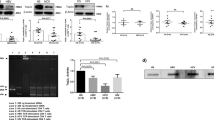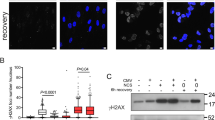Abstract
DNA amplification is a readily measurable indicator for genome destabilization. Contrary to normal senescing cells, those of most immortal or transformed cell lines are karyotypically unstable and permissive for amplification. Permissivity for amplification can be generated by gene products of several DNA tumor viruses whereby their interaction with the tumorsuppressor protein p53 is important. p53 is the major protein involved in check point control of DNA damage. Polyomavirus large T antigen is also involved in immortalization and transformation of cells but it does not interact with p53. We, therefore, examined whether this protein could still make the non-permissive cell line REF52 permissive for gene amplification. To this end REF52 cell lines were constructed which conditionally expressed the wild type polyomavirus large T antigen or a mutant form unable to bind the retinoblastoma protein. Using the inhibitor of de novo pyrimidine biosynthesis, phosphonoacetyl-L-aspartate (PALA), as selective agent we found that PALA resistant cells arise with a frequency of about 5×10−5 and that the interaction of polyomavirus large T protein with the retinoblastoma protein or another related pocket protein is important for this to occur. PALA resistant cells have an increased number of chromosomes and dicentric chromosomes which are considered as starting point for DNA structures characteristic for amplified DNA. Such structures were indeed found with the help of fluorescence in situ hybridization. PALA resistant cells appear normal with respect to p53. Our data indicate that PALA induces a G1 block which can be partially overcome by polyomavirus large T protein by its interaction with E2F-pocket protein complexes providing further evidence that these complexes are downstream targets of p53.
This is a preview of subscription content, access via your institution
Access options
Subscribe to this journal
Receive 50 print issues and online access
$259.00 per year
only $5.18 per issue
Buy this article
- Purchase on Springer Link
- Instant access to full article PDF
Prices may be subject to local taxes which are calculated during checkout
Similar content being viewed by others
Author information
Authors and Affiliations
Rights and permissions
About this article
Cite this article
Stiegler, P., Schüchner, S., Lestou, V. et al. Polyomavirus large T antigen-dependent DNA amplification. Oncogene 14, 987–995 (1997). https://doi.org/10.1038/sj.onc.1200904
Received:
Revised:
Accepted:
Issue Date:
DOI: https://doi.org/10.1038/sj.onc.1200904



